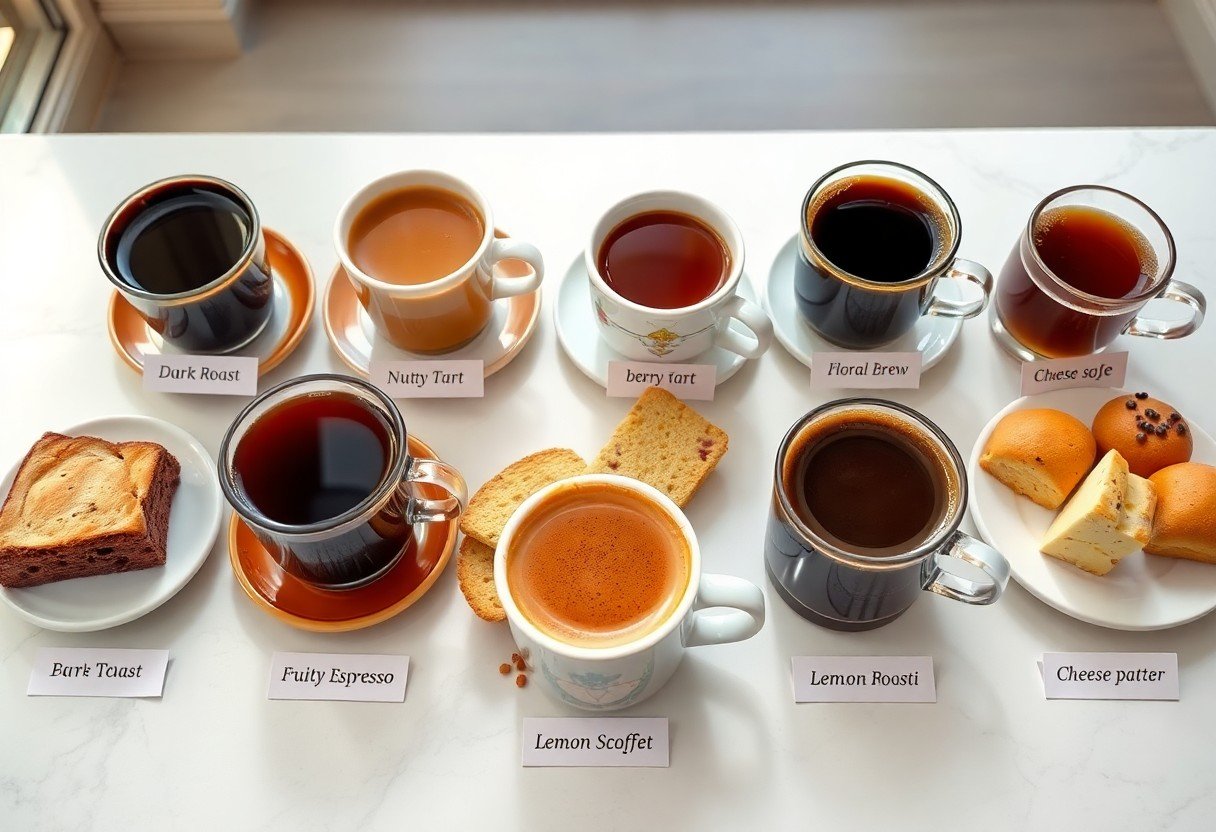Just as you savor the complexities of a fine meal, your experience can be elevated by thoughtfully pairing artisan coffee with food. Understanding the unique flavor profiles of different coffees allows you to enhance your culinary creations and create harmonious combinations that delight your palate. This guide will equip you with insights into selecting the right coffee to complement various dishes, unlocking a world of rich tastes and aromas that will transform your dining experience.
Unraveling Coffee’s Flavor Matrix
The complexity of coffee flavors originates from a multifaceted matrix of factors including origin, processing, and roasting techniques. Each element interplays uniquely to create the distinctive profiles you encounter in your cup. Understanding this matrix provides insights into how to best pair coffee with food, enhancing your overall tasting experience.
The Role of Terroir in Flavor Development
Understanding Roast Levels and Their Impact
Pairing Principles: Striking a Harmonious Balance
Balancing flavors in coffee and food creates an enjoyable sensory experience. Achieving this involves understanding how various elements—such as sweetness, bitterness, and body—interact. Aim for synergy between the dish and coffee, allowing each to enhance the other. Whether you choose to highlight specific flavor components or create a broader sensory experience, maintaining a coherent profile will result in a well-rounded pairing that delights the palate.
Complementing vs. Contrasting Flavors
In pairing, you can choose to complement or contrast flavors. Complementing involves matching similar notes, such as pairing a berry-flavored coffee with a chocolate dessert. Contrasting, on the other hand, introduces diverse profiles, like matching a bright, citrusy coffee with rich, creamy cheese. Both methods enhance the tasting experience, allowing you to explore a range of flavor dimensions.
The Art of Acidity in Pairing
Acidity acts as a vibrant component in both coffee and food, bringing freshness and brightness to pairings. In coffee, acidity can range from bright citrus-like notes to milder, fruity characteristics. When paired correctly with food, it can cut through richness or elevate subtle textures, adding complexity to your experience. An acidic coffee alongside a fatty dish like smoked salmon highlights flavors without overwhelming the palate.
Understanding the role of acidity in pairing can transform your culinary experiences. For instance, try a sparkling Ethiopian coffee with its lemony acidity against creamy desserts like panna cotta—this contrast cleanses your palate and generates excitement on the tongue. Acidity can also enhance savory dishes; consider a coffee with a tangy bite paired with rich foods like BBQ ribs or roasted duck, where the acidity counterbalances the fat and enhances depth. Experimenting with these interactions will deepen your appreciation for both coffee and cuisine.

Signature Flavor Profiles and Ideal Food Companions
Understanding signature flavor profiles in artisan coffee allows you to elevate your food pairings to new heights. Each coffee variety possesses unique characteristics that can enhance or contrast with your culinary choices, creating a memorable dining experience. By recognizing these profiles, you can tailor your selections to achieve ideal harmony on your palate.
Fruity and Floral Notes: Perfect Matches
Coffees with fruity and floral notes, such as Ethiopian Yirgacheffe, shine when paired with light and vibrant dishes. Consider complementing these flavors with salads featuring citrus vinaigrettes, or desserts like berry tarts and lemon meringue pies. The freshness of the coffee accentuates the natural sweetness and tartness of these foods, creating a delightful balance.
Nutty and Chocolatey Undertones: Savory Selections
Nuts and chocolate notes in coffee, commonly found in varieties like Brazilian Santos, pair splendidly with rich, savory dishes. These flavor profiles enhance foods like grilled steak with a chimichurri sauce, a creamy cheese platter featuring aged gouda, or even dark chocolate desserts. The interplay between the coffee’s undertones and the savory aspects of these dishes creates a luxurious tasting experience.
Rich, chocolatey undertones paired with nuts in coffee offer a base for robust flavor combinations. For instance, the smooth, nutty notes in a cup of Monsooned Malabar coffee harmonize beautifully with dishes that include roasted almonds or hazelnut pastes. Additionally, a pairing with a well-seasoned charcuterie board can enhance the savory sensations, allowing the coffee to brighten the flavors of cured meats and rich cheeses. As you explore these pairings, consider the texture and temperature of your dishes as well, as they can further influence flavor perception.

Practical Tips for Creating Flavor Pairing Menus
- Identify complementary flavors that enhance both coffee and food.
- Utilize sensory descriptions to convey the experience of each pairing.
- Experiment with varying roast levels to find the perfect match.
- Incorporate local and seasonal ingredients for freshness.
- Offer tasting notes to enrich the customer experience.
Perceiving the nuances in flavors helps create unforgettable pairings that enhance both coffee and culinary offerings.
Crafting a Thoughtful Coffee Menu
Developing a curated coffee menu requires understanding both the beans and potential pairings. Highlight distinct flavors and sourcing stories while considering how each coffee’s profile complements your food selections. Including tasting notes alongside beans helps guide customer choices and enriches their overall experience, making for an engaging dining atmosphere.
Building Flavor Profiles Around Seasonal Ingredients
Emphasizing seasonal ingredients allows your menu to resonate with current culinary trends and freshness. By pairing artisan coffee with local produce, proteins, and grains that are at their peak, you create a dynamic tasting experience. Seasonal foods bring natural sweetness or acidity that can beautifully complement specific coffee profiles, enhancing the flavors of both.
Building flavor profiles around seasonal ingredients not only highlights the freshness of your offerings but also creates a sense of connection with the local community. For instance, pairing a bright Ethiopian coffee with a dish featuring summer heirloom tomatoes can amplify the coffee’s fruity notes. Conversely, a rich Colombian coffee marries well with hearty autumn squash dishes, balancing earthiness with sweetness. By adapting your menu with seasons, you keep your offerings vibrant and aligned with customers’ desires for fresh and meaningful dining experiences.
Beyond the Basics: Innovating with Coffee Pairings
Elevating your coffee experience often involves stepping beyond conventional pairings. Explore combinations that challenge the status quo, like a bright citrus-forward coffee with a rich, creamy dessert or a smoky, dark roast alongside savory dishes. Experimenting with various roasting levels and brew methods opens avenues for unexpected flavors, enhancing both your coffee and culinary adventures. Embrace creativity to discover harmonious and enlightening pairings that surprise your palate.
Exploring Global Flavors: Culinary Inspirations
Your palate can travel the world through coffee pairings inspired by diverse cuisines. For instance, a fruity Ethiopian coffee effortlessly complements spicy Thai dishes, while a nutty Brazilian blend enhances the rich flavors of grilled meats. Look to international cuisines as a guide, marrying the flavor profiles of your favorite coffees with unique regional dishes to create captivating culinary experiences.
Experimenting with Alternative Pairings
Breaking away from conventional pairings can lead to delightful surprises. Consider pairing earthy, herbal coffee with dishes featuring miso or sesame, or enjoy a floral coffee alongside sushi for an intriguing contrast. The key is to keep an open mind about flavors. Think outside the box: a dark chocolate coffee paired with aged cheese can bring out layers of taste and complexity, creating a truly memorable dining experience.
To wrap up
Conclusively, pairing distinctive artisan coffee flavors with food enhances your culinary experience. You should consider the specific tasting notes of your coffee—be it fruity, nutty, or chocolatey—and match them with complementary dishes. For instance, a bright, citrusy brew works well with light pastries or breakfast items, while a richer, full-bodied coffee pairs beautifully with chocolate desserts or roasted meats. By experimenting and keeping your palate in mind, you can create delightful combinations that elevate both your coffee and your meals.
FAQ
Q: How can I enhance the flavor of my coffee with food pairings?
A: Choosing complementary flavors can enhance both the food and coffee experience. For example, fruity coffees pair well with desserts like tarts or pastries that have similar flavor notes, while chocolatey coffees suit rich desserts like brownies or dark chocolate cakes.
Q: What type of coffee pairs best with savory dishes?
A: Coffees with nutty or smoky profiles complement savory dishes. A medium roast with a hazelnut flavor can enhance grilled meats, while a dark roast with smoky notes could pair beautifully with barbecued dishes.
Q: Are there specific brewing methods that affect food pairing?
A: Yes, different brewing methods can extract various flavors from coffee. For example, pour-over techniques highlight bright and fruity notes, making them great for pairing with lighter foods like salads or fish, while a French press may provide a fuller body that goes well with hearty dishes.
Q: How do I choose coffee to pair with cheeses?
A: Pair mild cheeses with light, bright coffees to maintain balance, while stronger, aged cheeses go well with bolder brews that can stand up to their intense flavors. Aged cheddars work well with dark roast coffees, whereas goat cheese is delightful with a light, fruity blend.
Q: Can I pair coffee with breakfast foods?
A: Absolutely! Light roasted coffees often pair nicely with breakfast foods like pancakes or fruits due to their acidity. Richer, chocolatey coffees align well with pastries and oatmeal, creating a harmonious breakfast experience.

